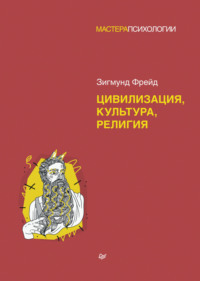 полная версия
полная версияA General Introduction to Psychoanalysis
I know that you have been wanting to interrupt me for a long time and to cry: "Enough of these monstrosities! Excretion a source of sexual gratification that even the suckling exploits! Faeces a valuable substance! The anus a sort of genital! We do not believe it, but we understand why children's physicians and pedagogues have decidedly rejected psychoanalysis and its results." No, you have merely forgotten that it was my intention to present to you infantile sexuality in connection with the facts of sexual perversion. Why should you not know that in the case of many grown-ups, homosexuals as well as heterosexuals, the locus of intercourse is transferred from the normal to a more remote portion of the body. And that there are many individuals who confess to a pleasurable sensation of no slight degree in the emptying of the bowels during their entire lives! Children themselves will confirm their interest in the act of defecation and the pleasure in watching the defecation of another, when they are a few years older and capable of giving expression to their feelings. Of course, if these children have previously been systematically intimidated, they will understand all too well the wisdom of preserving silence on the subject. As for the other things that you do not wish to believe, let me refer you to the results of analysis and the direct observation of children, and you will realize that it is difficult not to see these things or to see them in a different light. I do not even object to making the relation between child-sexuality and sexual perversion quite obvious to you. It is really only natural; if the child has sexual life at all, it must necessarily be perverse, because aside from a few hazy illusions, the child does not know how sexuality gives rise to reproduction. The common characteristic of all perversions, on the other hand, is that they have abandoned reproduction as their aim. We term sexual activity perverse when it has renounced the aim of reproduction and follows the pursuit of pleasure as an independent goal. And so you realize that the turning point in the development of sexual life lies in its subjugation to the purpose of reproduction. Everything this side of the turning point, everything that has given up this purpose and serves the pursuit of pleasure alone, must carry the term "perverse" and as such be regarded with contempt.
Permit me, therefore, to continue with my brief presentation of infantile sexuality. What I have told you about two organic systems I could supplement by a discussion of all the others. The sexual life of the child exhausts itself in the exercise of a series of partial instincts which seek, independently of one another, to gain satisfaction from his own body or from an external object. Among these organs the genitals speedily predominate. There are persons who continue the pursuit of satisfaction by means of their own genitals, without the aid of another genital or object, uninterruptedly from the onanism of the suckling to the onanism of necessity which arises in puberty, and even indefinitely beyond that. The theme of onanism alone would occupy us for a long period of time; it offers material for diverse observations.
In spite of my inclination to shorten the theme, I must tell you something about the sexual curiosity of children. It is most characteristic for child sexuality and significant for the study of neurotic symptoms. The sexual curiosity of children begins very early, sometimes before the third year. It is not connected with the differences of sexes, which means nothing to the child, since the boy, at any rate, ascribes the same male genital to both sexes. When the boy first discovers the primary sexual structure of the female, he tries at first to deny the evidence of his senses, for he cannot conceive a human being who lacks the part of his body that is of such importance to him. Later he is terrified at the possibility revealed to him and he feels the influence of all the former threats, occasioned by his intensive preoccupation with his little organ. He becomes subject to the domination of the castration complex, the formation of which plays an important part in the development of his character, provided he remains healthy; of his neurosis, if he becomes diseased; of his resistance, if he is treated analytically. We know that the little girl feels injured on account of her lack of a large, visible penis, envies the boy his possession, and primarily from this motive desires to be a man. This wish manifests itself subsequently in neurosis, arising from some failure in her role as a woman. During childhood, the clitoris of the girl is the equivalent of the penis; it is especially excitable, the zone where auto-erotic satisfaction is achieved. In the transition to womanhood it is most important that the sensations of the clitoris are completely transferred at the right time to the entrance of the vagina. In cases of so-called sexual anesthesia of women the clitoris has obstinately retained its excitability.
The sexual interest of children generally turns first to the mystery of birth – the same problem that is the basis of the questions asked by the sphinx of Thebes. This curiosity is for the most part aroused by the selfish fear of the arrival of a new child. The answer which the nursery has ready for the child, that the stork brings children, is doubted far more frequently than we imagine, even by very young children. The feeling that he has been cheated out of the truth by grown-ups, contributes greatly to the child's sense of solitude and to his independent development. But the child is not capable of solving this problem unaided. His undeveloped sexual constitution restricts his ability to understand. At first he assumes that children are produced by a special substance in one's food and does not know that only women can bear children. Later he learns of this limitation and relinquishes the derivation of children from food – a supposition retained in the fairy-tale. The growing child soon notices that the father plays some part in reproduction, but what it is he cannot guess. If, by chance, he is witness of a sexual act, he sees in it an attempt to subjugate, a scuffle, the sadistic miscomprehension of coitus; he does not however relate this act immediately to the evolution of the child. When he discovers traces of blood on the bedsheets or on the clothing of his mother, he considers them the proof of an injury inflicted by the father. During the latter part of childhood, he imagines that the sexual organ of the man plays an important part in the evolution of children, but can ascribe only the function of urination to that part of his body.
From the very outset children unite in believing that the birth of the child takes place through the anus; that the child therefore appears as a ball of faeces. After anal interests have been proven valueless, he abandons this theory and assumes that the navel opens or that the region between the two breasts is the birthplace of the child. In this way the curious child approaches the knowledge of sexual facts, which, clouded by his ignorance, he often fails to see. In the years prior to puberty he generally receives an incomplete, disparaging explanation which often causes traumatic consequences.
You have probably heard that the conception "sexual" is unduly expanded by psychoanalysis in order that it may maintain the hypothesis that all neuroses are due to sexual causes and that the meaning of the symptoms is sexual. You are now in a position to judge whether or not this expansion is unjustifiable. We have expanded the conception sexual only to include the sexual life of children and of perverse persons. That is to say, we have reëstablished its proper boundaries. Outside of psychoanalysis sexuality means only a very limited thing: normal sexual life in the service of reproduction.
TWENTY-FIRST LECTURE
GENERAL THEORY OF THE NEUROSES
Development of the Libido and Sexual OrganizationsI AM under the impression that I did not succeed in convincing you of the significance of perversions for our conception of sexuality. I should therefore like to clarify and add as much as I can.
It was not only perversions that necessitated an alteration of our conception of sexuality, which aroused such vehement contradiction. The study of infantile sexuality did a great deal more along that line, and its close correspondence to the perversions became decisive for us. But the origin of the expressions of infantile sexuality, unmistakable as they are in later years of childhood, seem to be lost in obscurity. Those who disregard the history of evolution and analytic coherence, will dispute the potency of the sexual factor and will infer the agency of generalized forces. Do not forget that as yet we have no generally acknowledged criterion for identifying the sexual nature of an occurrence, unless we assume that we can find it in a relation to the functions of reproduction, and this we must reject as too narrow. The biological criteria, such as the periodicities of twenty-three and twenty-eight days, suggested by W. Fliess, are by no means established; the specific chemical nature which we can possibly assume for sexual occurrences is still to be discovered. The sexual perversions of adults, on the other hand, are tangible and unambiguous. As their generally accepted nomenclature shows, they are undoubtedly sexual in character; whether we designate them as signs of degeneration, or otherwise, no one has yet had the courage to place them outside the phenomena of sex. They alone justify the assertion that sexuality and reproduction are not coincident, for it is clear that all of them disavow the goal of reproduction.
This brings me to an interesting parallel. While "conscious" and "psychic" were generally considered to be identical, we had to make an essay to widen our conception of the "psychic" to recognize as psychic something that was not conscious. Analogously, when "sexual" and "related to reproduction" (or, in shorter form, "genital") has been generally considered identical, psychoanalysis must admit as "sexual" such things as are not "genital," things which have nothing to do with reproduction. It is only a formal analogy, but it does not lack a deeper basis.
But if the existence of sexual perversions is such a compelling argument, why has it not long ago had its effect, and settled the question? I really am unable to say. It appears to be because the sexual perversions are subject to a peculiar ban that extends even into theory, and stands in the way of their scientific appreciation. It seems as if no one could forget that they are not only revolting, but even unnatural, dangerous; as if they had a seductive influence and that at bottom one had to stifle a secret envy of those who enjoyed them. As the count who passes judgment in the famous Tannhauser parody admits:
"And in the mount of Venus, his honor slipped his mind,It's odd that never happens to people of our kind."Truthfully speaking, the perverts are rather poor devils who atone most bitterly for the satisfaction they attain with such difficulty.
What makes the perverse activity unmistakably sexual, despite all the strangeness of its object, is that the act in perverse satisfaction most frequently is accompanied by a complete orgasm, and by an ejaculation of the genital product. Of course, this is only true in the case of adults; with children orgasms and genital excretions are hardly possible; they are replaced by rudiments which, again, are not recognized as truly sexual.
In order to complete the appreciation of sexual perversions, I have something to add. Condemned as they are, sharply as they are contrasted with the normal sexual activity, simple observation shows that rarely is normal sex-life entirely free from one or another of the perverse traits. Even the kiss can be claimed to be perverse, for it consists in the union of two erogenous mouth zones in place of the respective genitals. But no one outlaws it as perverse, it is, on the contrary, admitted in theatrical performances as a modified suggestion of the sexual act. This very kissing may easily become a complete perversion if it results in such intensity that it is immediately followed by an emission and orgasm – a thing that is not at all unusual. Further, we can learn that handling and gazing upon the object becomes an essential prerequisite to sexual pleasure; that some, in the height of sexual excitation, pinch and bite, that the greatest excitation is not always called forth in lovers by the genitals, but rather by other parts of the body, and so forth. There is no sense in considering persons with single traits of this kind abnormal, and counting them among the perverts. Rather, we recognize more and more clearly that the essential nature of perversion does not consist in overstepping the sexual aim, nor in a substitution for the genitals, not even in the variety of objects, but simply in the exclusiveness with which these deviations are carried out and by means of which the sexual act that serves reproduction is pushed aside. When the perverse activities serve to prepare or heighten the normal sexual act, they are really no longer perversions. To be sure, the chasm between normal and perverse sexuality is practically bridged by such facts. The natural result is that normal sexuality takes its origin from something existing prior to it, since certain components of this material are thrown out and others are combined in order to make them subject to a new aim – that of reproduction.
Before we make use of our knowledge of perversions to concentrate anew and with clearer perspective on the study of infantile sexuality, I must call your attention to an important difference between the two. Perverse sexuality is as a rule extraordinarily centralized, its whole action is directed toward one, usually an isolated, goal. A partial instinct has the upper hand. It is either the only one that can be demonstrated or it has subjected the others to its purposes. In this respect there is no difference between normal and perverse sexuality other than that the ruling partial instincts, and with them the sexual goals, are different. In the one case as well as in the other there is, so to say, a well organized tyranny, excepting that here one family and there another has appropriated all the power to itself. Infantile sexuality, on the other hand, is on the whole devoid of such centralization and organization, its individual component impulses are of equal power, and each independently goes in search of the acquisition of pleasurable excitement. The lack as well as the presence of centralization fit in well with the fact that both the perverse and the normal sexuality originated from the infantile. There are also cases of perverse sexuality that have much more similarity with the infantile, where, independently of one another, numerous partial instincts have forced their way, insisted on their aims, or rather perpetuated them. In these cases it is more correct to speak of infantilism of sexual life than of perversions.
Thus prepared we can consider a question which we certainly shall not be spared. People will say to us: "Why are you so set on including within sexuality those manifestations of childhood, out of which the sexual later develops, but which, according to your own admission, are of uncertain origin? Why are you not satisfied rather with the physiological description, and simply say that even in the suckling one may notice activities, such as sucking objects or holding back excrements, which show us that he strives towards an organic pleasure? In that way you would have avoided the estranging conception of sexual life in the tiniest child." I have nothing to say against organic pleasure; I know that the most extreme excitement of the sexual union is only an organic pleasure derived from the activity of the genitals. But can you tell me when this organic pleasure, originally not differentiated, acquires the sexual character that it undoubtedly does possess in the later phases of development? Do you know more about the "organic pleasure" than about sexuality? You will answer, the sexual character is acquired when the genitals begin to play their role; sexual means genital. You will even reject the contrary evidence of the perversions by confronting me with the statement that in most perversions it is a matter of achieving the genital orgasm, although by other means than a union of the genitals. You would really command a much better position if you did not regard as characteristic of the sexual that untenable relation to reproduction seen in the perversions, if you replaced it by activity of the genitals. Then we no longer differ very widely; the genital organs merely replace other organs. What do you make of the numerous practices which show you that the genitals may be represented by other organs in the attainment of gratification, as is the case in the normal kiss, or the perverse practices of "fast life," or the symptoms of hysteria? In these neuroses it is quite usual for stimulations, sensations and innervations, even the process of erection, which is localized in the genitals, to be transferred to other distant parts of the body, so that you have nothing to which you can hold as characteristics of the sexual. You will have to decide to follow my example and expand the designation "sexual" to include the strivings of early childhood toward organic pleasure.
Now, for my justification, I should like you to give me the time for two more considerations. As you know, we call the doubtful and indefinable pleasure activities of earliest childhood sexual because our analysis of the symptoms leads us to them by way of material that is undeniably sexual. We admit that it need not for that reason in itself be sexual. But take an analogous case. Suppose there were no way to observe the development of two dicotyledonous plants from their seeds – the apple tree and the bean. In both cases, however, imagine it possible to follow their evolution from the fully developed plant backwards to the first seedling with two leaf-divisions. The two little leaves are indistinguishable, in both cases they look exactly alike. Shall I conclude from this that they really are the same and that the specific differences between an apple tree and bean plant do not appear until later in the history of the plant? Or is it biologically more correct to believe that this difference is already present in the seedling, although the two little leaves show no differences? We do the same thing when we term as sexual the pleasure derived from the activities of the suckling. Whether each and every organic enjoyment may be called sexual, or if besides the sexual there is another that does not deserve this name, is a matter I cannot discuss here. I know too little about organic pleasure and its conditions, and will not be at all surprised if the retrogressive character of the analysis leads us back finally to a generalized factor.
One thing more. You have on the whole gained very little for what you are so anxious to maintain, the sexual purity of the child, even when you can convince me that the activities of the suckling had better not be called sexual. For from the third year on, there is no longer any doubt concerning the presence of a sexual life in the child. At this time the genitals already begin to become active; there is perhaps regularly a period of infantile masturbation, in other words, a gratification by means of the genitals. The psychic and social expressions of the sexual life are no longer absent; choice of an object, affectionate preference for certain persons, indeed, a leaning toward one of the two sexes, jealousy – all these have been established independently by unprejudiced observation, prior to the advent of psychoanalysis, and confirmed by every careful observer. You will say that you had no doubt as to the early awakening of affection, you will take issue only with its sexual nature. Children between the ages of three and eight have already learned to hide these things, but if you look sharply you can always gather sufficient evidence of the "sexual" purpose of this affection. What escapes you will be amply supplied by investigation. The sexual goals of this period of life are most intimately connected with the contemporaneous sexual theories, of which I have given you some examples. The perverse nature of some of these goals is the result of the constitutional immaturity of the child, who has not yet discovered the goal of the act of copulation.
From about the sixth or the eighth year on a pause in, and reversion of, sexual development is noticeable, which in the cases that reach the highest cultural standard deserves the name of a latent period. The latent period may also fail to appear and there need not be an interruption of sexual activity and sexual interests at any period. Most of the experiences and impulses prior to the latent period then fall victim to the infantile amnesia, the forgetting we have already discussed, which cloaks our earliest childhood and makes us strangers to it. In every psychoanalysis we are confronted with the task of leading this forgotten period of life back into memory; one cannot resist the supposition that the beginning of sexual life it contains furnishes the motive for this forgetting, namely, that this forgetting is a result of suppression.
The sexual life of the child shows from the third year that it has much in common with that of the adult; it is distinguished from the latter, as we already know, by the lack of stable organization under the primacy of the genitals, by the unavoidable traits of perversion, and, naturally, by the far lesser intensity of the whole impulse. Theoretically the most interesting phases of the sexual development or, as we would rather say, the libido-development, so far as theory is concerned, lie back of this period. This development is so rapidly gone through that perhaps it would never have been possible for direct observation to grasp its fleeting pictures. Psychoanalytic investigation of the neuroses has for the first time made it possible to discover more remote phases of the libido-development. These are, to be sure, nothing but constructions, but if you wish to carry on psychoanalysis in a practical way you will find that they are necessary and valuable constructions. You will soon understand why pathology may disclose conditions which we would have overlooked in the normal object.
We can now declare what form the sexual life of the child takes before the primacy of the genitals is established. This primacy is prepared in the first infantile epoch prior to the latent period, and is continuously organized from puberty on. There is in this early period a sort of loose organization, which we shall call pre-genital. In the foreground of this phase, however, the partial instincts of the genitals are not prominent, rather the sadistic and anal. The contrast between masculine and feminine plays no part as yet, its place is taken by the contrast between active and passive, which we may designate as the forerunner of sexual polarity, with which it is later fused. That which appears masculine to us in the activity of this phase, observed from the standpoint of the later genital stage, is the expression of an instinct to mastery, which may border on cruelty. Impulses with passive goals attach themselves to the erogenous zone of the rectal opening. Most important at this time, curiosity and the instinct to watch are powerful. The genital really takes part in the sexual life only in its role as excretory organ for the bladder. Objects are not lacking to the partial impulses of this period, but they do not necessarily combine into a single object. The sadistico-anal organization is the step antecedent to the phase of genital primacy. A more penetrating study furnishes proof how much of this is retained for the later and final form, and in what ways its partial instincts are forced into line under the new genital organization. Back of the sadistico-anal phase of libido-development, we get a view of an earlier, even more primitive phase of organization, in which the erogenous mouth-zone plays the chief role. You may surmise that the sexual activity of sucking belongs to it, and may wonder at the intuition of the ancient Egyptians, whose art characterized the child, as well as the god Horus, with the finger in his month. Abraham only recently published material concerning the traces which this primitive oral phase has left upon the sexual life of later years.











